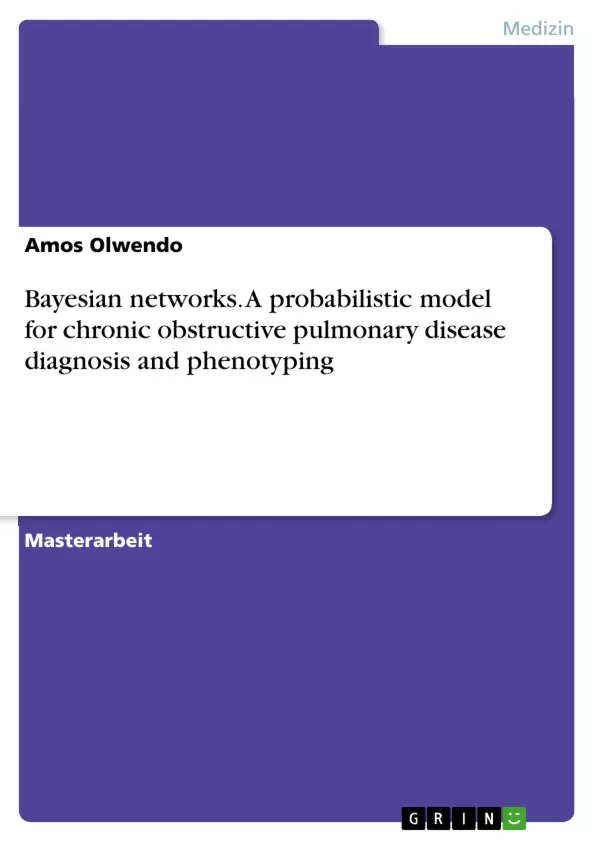This thesis provides a model for diagnosing and classifying COPD based on phenotypes; General COPD, Chronic bronchitis, Emphysema, and the Asthmatic COPD using a Bayesian network (BN). A BN is a probabilistic modelling tool composed of random variables and the relationships of such variables is based on probabilities that maximize certain outcomes. We validated our BN model using a neural network model based on the Levenberg- Marquardt (LM) algorithm. Results show that the BN model achieved an overall classification of 98.75 % for our test cases. Furthermore, F1 score results also show that the BN is a better model for COPD classification in comparison to the LM algorithm.
The World Health Organization (WHO) lists COPD as the fourth leading cause of the death worldwide yet the disease is preventable. Smoking of tobacco products, alpha-1-antitrypsin (AAt), and air pollution are the major risk factors associated with the development and progression of this disease. COPD is usually either misdiagnosed or under-diagnosed due to a number of factors including the slow progression of the development of its symptoms. Besides, differential diagnosis is usually applied during diagnosis because differentiating COPD patients from those with say chronic Asthma may not be an easy task. Previous researchers have used pulmonary function test results to diagnose COPD.
Inhaltsverzeichnis
- Abstract
- Acknowledgements
- Chapter 1: Introduction
- 1.1: Introduction to COPD
- 1.2: Background on COPD
- 1.3: Diagnosis and Phenotyping of COPD
- 1.4: Research Gaps and Objectives
- Chapter 2: Review of Literature
- 2.1: Epidemiology of COPD
- 2.2: Risk Factors for COPD
- 2.3: Pathophysiology of COPD
- 2.4: Diagnosis of COPD
- 2.5: Treatment of COPD
- 2.6: Bayesian Networks
- Chapter 3: Methodology
- 3.1: Study Design
- 3.2: Data Collection
- 3.3: Bayesian Network Model Development
- 3.4: Model Validation
- Chapter 4: Results and Discussion
- 4.1: Model Evaluation
- 4.2: Discussion of Findings
- Chapter 5: Conclusion
Zielsetzung und Themenschwerpunkte
Diese Masterarbeit widmet sich der Entwicklung eines probabilistischen Modells zur Diagnose und Phänotypisierung von COPD unter Verwendung von Bayesian Networks. Das Ziel ist es, eine zuverlässige und effiziente Methode zu erstellen, die die Diagnose und Klassifizierung von COPD-Patienten unterstützt, insbesondere unter Berücksichtigung der unterschiedlichen Phänotypen.
- Entwicklung eines Bayesian Network-Modells zur Diagnose von COPD
- Klassifizierung von COPD-Patienten in verschiedene Phänotypen
- Bewertung der Leistung des entwickelten Modells durch Validierung mit einem neuronalen Netzwerkmodell
- Analyse der Ergebnisse und Diskussion der Implikationen für die klinische Praxis
- Identifizierung von potenziellen Anwendungen und zukünftigen Forschungsrichtungen für die Diagnose und Behandlung von COPD
Zusammenfassung der Kapitel
- Kapitel 1: Einführung: Diese Einleitung führt in das Thema COPD ein, beleuchtet die Epidemiologie, die Risikofaktoren und die Herausforderungen bei der Diagnose und Behandlung der Krankheit. Außerdem werden die Forschungslücken und die Ziele der Studie erläutert.
- Kapitel 2: Literaturüberblick: Dieses Kapitel bietet einen umfassenden Überblick über den aktuellen Forschungsstand zur COPD. Es umfasst epidemiologische Daten, Risikofaktoren, die Pathophysiologie der Krankheit, Diagnostik- und Behandlungsmethoden sowie die Grundlagen von Bayesian Networks.
- Kapitel 3: Methodik: Dieses Kapitel beschreibt die Methodik der Studie, einschließlich des Studiendesigns, der Datenerhebung, der Entwicklung des Bayesian Network-Modells und der Validierung des Modells.
- Kapitel 4: Ergebnisse und Diskussion: Dieses Kapitel präsentiert die Ergebnisse der Modellbewertung und diskutiert die Ergebnisse im Kontext der Literatur und der klinischen Implikationen.
Schlüsselwörter
Chronisch obstruktive Lungenerkrankung (COPD), Bayesian Networks, Diagnose, Phänotypisierung, probabilistisches Modell, neuronale Netzwerke, Levenberg-Marquardt-Algorithmus, Klassifizierung, F₁-Score, Risikofaktoren, Epidemiologie, Pathophysiologie, Behandlung.
- Citar trabajo
- Amos Olwendo (Autor), 2014, Bayesian networks. A probabilistic model for chronic obstructive pulmonary disease diagnosis and phenotyping, Múnich, GRIN Verlag, https://www.grin.com/document/505955



